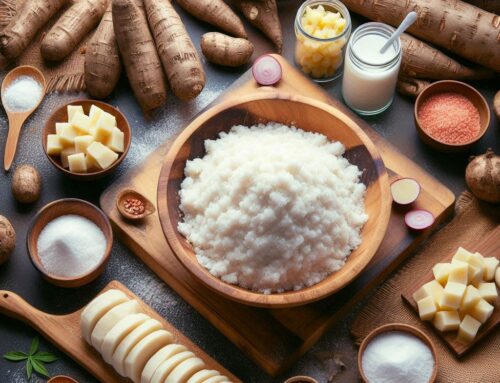
Introduction: Understanding the Role of Cassava in Animal Nutrition
Cassava, a root crop native to South America, has emerged as a valuable component in animal nutrition due to its versatility and nutritional benefits. As the demand for sustainable and cost-effective feed solutions grows, cassava offers an alternative feed source that can be integrated into livestock diets.
One of the primary advantages of using cassava in animal feed is its high carbohydrate content, which provides a rich energy source for animals. This makes it particularly beneficial for livestock such as cattle, pigs, and poultry. Cassava’s role in animal nutrition extends beyond just energy provision; it also contains essential nutrients like calcium and phosphorus, which contribute to healthy bone development.
Furthermore, cassava is considered an excellent alternative feed source due to its adaptability in various climates and soil conditions. It can be cultivated in regions where traditional grains might struggle to grow, making it a reliable option for farmers seeking resilient crops.
Despite these benefits, it’s important to note that cassava should be processed correctly before being used as animal feed. Raw cassava contains cyanogenic glycosides that can produce cyanide if not properly treated. However, through methods such as drying or fermenting, these compounds can be effectively reduced or eliminated.
Incorporating cassava into livestock diets not only taps into its nutritional potential but also supports agricultural sustainability by diversifying feed sources. As research continues to explore the full scope of its benefits and applications, cassava stands out as a promising component in the future of animal nutrition strategies.
The Benefits of Using Cassava as Animal Feed
Cassava, a versatile root crop, is gaining attention in the agricultural sector for its benefits as animal feed. One of the primary advantages of using cassava as animal fodder is its role in providing a high-energy diet for animals. Rich in carbohydrates, cassava serves as an excellent energy source, supporting growth and productivity in livestock such as cattle, pigs, and poultry.
Moreover, cassava feed benefits extend to its cost-effectiveness. Compared to traditional grains like corn and soybeans, cassava can be cultivated with lower input costs and on marginal lands where other crops might not thrive. This makes it an economically viable option for farmers looking to reduce feeding expenses without compromising on nutritional value.
Additionally, incorporating cassava into feeding regimens contributes to sustainable feeding solutions. Cassava’s adaptability to various climates and resistance to drought conditions make it a reliable crop that supports food security while minimizing environmental impact. By integrating cassava into animal diets, farmers can leverage this resilient crop to create more sustainable agricultural practices that benefit both their livestock and the planet.
How to Process Cassava Safely for Livestock Consumption
Cassava is a valuable feed resource for livestock, but it requires careful processing to ensure safety due to its natural cyanogenic compounds. Understanding the right cassava processing methods is crucial for detoxifying cassava roots and making them safe for animal consumption.
One of the most effective ways to detoxify cassava is through drying techniques. Sun-drying or oven-drying the peeled and grated cassava roots helps reduce cyanide content significantly. By spreading thin layers of grated cassava in direct sunlight or using controlled heat, moisture evaporates, allowing harmful compounds to dissipate. This method not only makes the roots safer but also extends their shelf life.
Fermentation techniques offer another reliable method for preparing cassava safely. By fermenting grated cassava in water or with specific bacterial cultures, cyanide levels can be reduced further. The fermentation process breaks down toxins while enhancing nutritional value, making it an excellent choice for livestock feed preparation.
Safe preparation practices are essential throughout these processes. It’s vital to peel the roots thoroughly before any treatment since most toxins are concentrated in the outer layers. Additionally, ensuring that all equipment used is clean and free from contamination will help maintain high hygiene standards during processing.
By employing these drying and fermentation techniques as part of your safe preparation practices, you can confidently use processed cassava as a nutritious component of livestock diets without compromising on safety.
Nutritional Content of Cassava and Its Impact on Different Animals
Cassava, a starchy root crop, is increasingly being recognized for its potential as a feed ingredient in animal diets. A thorough nutritional analysis of cassava feed reveals that it is predominantly composed of carbohydrates, making it an excellent energy source for various animals. However, its protein content is relatively low compared to other feed options, necessitating supplementation with protein-rich ingredients when formulating balanced diets.
When feeding cassava to cattle, the high carbohydrate content can support energy needs but should be complemented with additional protein sources to ensure optimal growth and milk production. For poultry, cassava can serve as an effective substitute for conventional grains; however, the inclusion rate must be carefully managed due to its low protein levels and potential anti-nutritional factors which can affect digestibility.
In sheep and goats, cassava can be used as an energy supplement but should not replace forage entirely due to the need for fiber in their diet. Similarly, pigs can benefit from the energy density of cassava feed; however, balancing it with adequate protein and essential amino acids is crucial to support their rapid growth rates.
Overall, while cassava offers a valuable alternative in animal nutrition due to its carbohydrate richness and cost-effectiveness, careful formulation and supplementation are key when incorporating it into the diets of cattle, poultry, sheep, goats, and pigs. By understanding these nuances in nutritional content and impact on different animals, farmers can optimize their feeding strategies for better productivity and health outcomes.
Common Challenges in Preparing Cassava as Animal Feed and How to Overcome Them
Cassava is a versatile and valuable crop for animal feed, but its preparation poses several challenges that need careful attention to ensure safety and nutritional value. One of the primary difficulties with cassava preparation is the presence of cyanogenic glycosides, which can release toxic hydrogen cyanide when consumed. To reduce cyanide levels in cassava roots, leaves, and peels, it’s essential to employ proper processing techniques such as soaking, drying, fermenting, or boiling. These methods help break down the glycosides and significantly lower the risk of toxicity.
Another challenge lies in storage issues for processed cassavas. Due to their high moisture content, processed cassavas are prone to spoilage if not stored correctly. To overcome this hurdle, it’s crucial to dry the cassava thoroughly before storage and keep it in a cool, dry environment to prevent mold growth and nutrient loss. Utilizing airtight containers or bags can also help maintain quality by protecting against moisture and pests.
By addressing these common challenges through effective processing and storage strategies, farmers can enhance the safety and efficiency of using cassava as animal feed while maximizing its nutritional benefits for livestock.
Cassava Feeding Ratios: Ensuring a Balanced Diet for Your Animals
Cassava is a versatile and energy-rich feed ingredient that, when used correctly, can be an excellent addition to animal diets. However, achieving the right balance is crucial to maximizing its health benefits while ensuring your animals receive a well-rounded diet. Understanding suitable feeding ratios with cassavas is essential for maintaining optimal animal health.
When incorporating cassava into animal feed, it’s important to consider the nutritional profile of cassava and how it complements other dietary components. Cassava is high in carbohydrates but relatively low in protein and other essential nutrients. Therefore, balancing nutrition with other feeds is necessary to meet the complete dietary needs of your livestock.
Dietary recommendations suggest that cassava should not exceed 30-40% of the total diet for most animals. This ensures that animals receive enough protein and micronutrients from other sources such as legumes or commercial feed supplements. By carefully determining suitable feeding ratios with cassavas alongside these complementary feeds, you can enhance energy intake without compromising on overall nutrition.
Incorporating diverse feed ingredients in conjunction with cassava allows farmers to maximize health benefits while promoting growth and productivity in their herds or flocks. Regular monitoring of animal health and performance will help fine-tune these ratios over time, ensuring a balanced diet tailored to specific needs and environmental conditions.
Conclusion: Implementing Best Practices for Effective Use of Cassavas in Animal Feeding Programs
In conclusion, implementing best practices for the effective use of cassavas in animal feeding programs requires a comprehensive understanding of both the nutritional benefits and potential challenges associated with this versatile crop. Cassavas offer a valuable source of energy due to their high carbohydrate content, making them an excellent alternative feed ingredient in regions where traditional grains may be scarce or expensive. However, it is crucial to address the presence of cyanogenic glycosides by employing proper processing techniques such as peeling, drying, and fermenting to ensure safety and palatability for livestock.
To maximize the benefits of cassava-based feeds, animal nutritionists should consider formulating balanced diets that complement cassava’s nutritional profile with adequate protein sources and essential vitamins and minerals. Regular monitoring and evaluation of animal performance can help fine-tune these formulations to meet specific growth or production targets.
Furthermore, engaging local farmers in training programs about cultivation practices and post-harvest handling can enhance the quality and availability of cassavas for feed purposes. By fostering collaboration among agricultural experts, feed manufacturers, and livestock producers, we can effectively integrate cassavas into sustainable feeding strategies that support food security while promoting economic resilience in rural communities.






